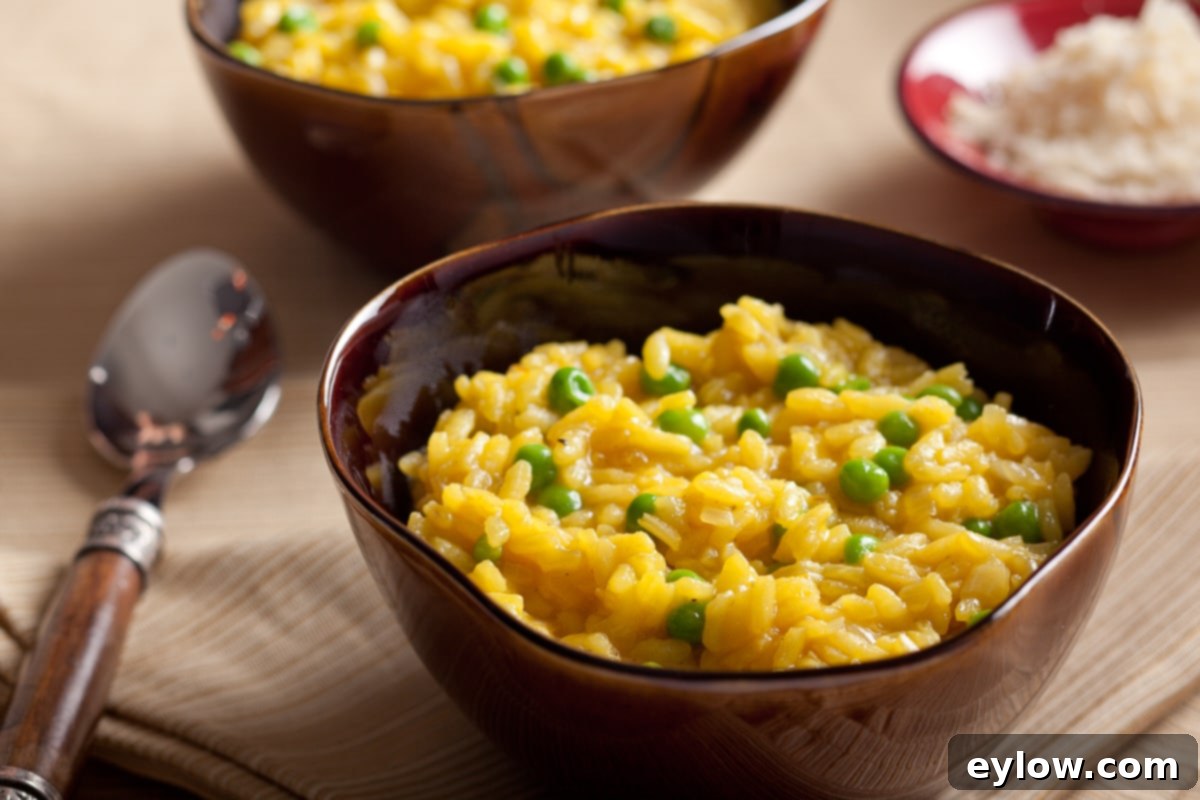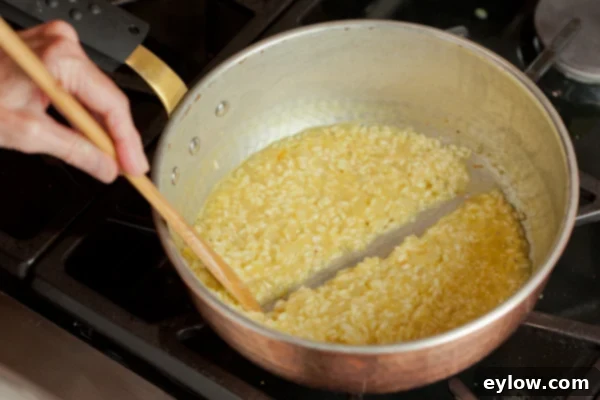Authentic Saffron Risotto Milanese with Peas: Your Guide to a Creamy Italian Classic
Embark on a culinary journey to Northern Italy with this exquisite Saffron Risotto Milanese, a dish that transforms simple ingredients into a truly unforgettable experience. Imagine slowly stirring fragrant, golden broth, infused with precious saffron threads, into plump Italian short-grain rice until each grain is tender yet firm, enveloped in a luxurious, creamy sauce. It’s more than just cooking; it’s a meditative process, a moment of culinary therapy in your own kitchen. A splash of fine white wine for the pan, and perhaps a glass for the chef, sets the mood for creating this classic Italian masterpiece. My personal favorite rendition, perfected over decades, includes tender green peas, adding a delightful burst of freshness and color. This dish is not only a celebration of flavor but also incredibly versatile, serving as a hearty main course topped with succulent shrimp, pan-seared scallops, diced chicken, or flavorful sausage, or as an elegant side dish to complement any meal. Risotto is, quite simply, heavenly. While it asks for a little patience and a loving hand with the stirring spoon, that very first creamy, savory bite will undoubtedly make every moment worthwhile.

I’ve been honing this saffron risotto recipe for decades, and it has truly become a staple in my kitchen. Mastering the fundamental techniques of risotto opens up a world of delightful variations, allowing you to customize this incredible rice dish to your heart’s content. When asked about my ultimate last meal, my answer almost always involves a luxurious Risotto Milanese with lobster, perfectly paired with a crisp glass of Champagne. While that’s reserved for special occasions like holidays, this simpler, yet equally satisfying, pea-infused saffron risotto makes a regular appearance on my table throughout the cozy fall and winter months. It’s a comforting classic that consistently delivers rich flavor and a wonderfully creamy texture.
Why You’ll Adore This Creamy Saffron Risotto
There are countless reasons to fall in love with this authentic saffron risotto recipe. It’s a dish that appeals to the senses and offers incredible culinary satisfaction. Here’s why it deserves a spot in your cooking repertoire:
- Ultimate Comfort Food: If you’re a fan of rice dishes, risotto takes comfort food to an entirely new level. Its warm, creamy texture and rich flavor provide a deeply satisfying experience, perfect for a cozy evening at home.
- Pantry-Friendly Ingredients: Many of the essential ingredients for this saffron risotto are staples you likely already have on hand, or can easily keep stocked in your pantry. This makes it a convenient and accessible meal to prepare anytime.
- Endless Versatility: Once you master the basic technique, the possibilities for variations are limitless. From adding different vegetables to various proteins, you can easily adapt this base recipe to create new and exciting dishes every time.
- Perfect for Pairing: Saffron risotto serves as an excellent foundation for a variety of proteins. Enhance it by topping with perfectly seared scallops, juicy shrimp, tender diced chicken, savory cooked sausage, or any other meat of your choice. It’s truly a complete meal in a pan.
- Elegant Yet Simple: Despite its sophisticated presentation and rich flavor, making risotto isn’t as intimidating as it seems. With a little guidance, you can achieve a restaurant-quality dish that’s sure to impress.
Essential Ingredients for Authentic Risotto Milanese
To create a truly remarkable Risotto Milanese, a dish renowned for its golden hue and incredible flavor, selecting high-quality ingredients is paramount. This classic Italian rice dish, also known as Risotto alla Milanese, relies on a few key components to achieve its distinctive taste and creamy texture. Here’s a closer look at what you’ll need:
- Chicken Broth: The backbone of any good risotto is its broth. This is an ideal opportunity to use homemade chicken broth, which offers unparalleled depth of flavor. If purchasing, opt for a low-sodium, high-quality variety. Always check labels and consider freezer-section options for superior taste. The warmth and flavor of the broth are crucial as it slowly absorbs into the rice, contributing significantly to the final dish.
- Saffron: Known as the “king of spices,” saffron is indispensable for authentic Milanese risotto. Its vibrant red threads impart a beautiful golden color and a subtly sweet, earthy, and floral aroma that defines this dish. While it is the world’s most expensive spice, only a small amount is needed, making it an affordable luxury for this recipe. Ensure you crush the saffron threads slightly before steeping them in the warm broth to maximize their flavor release.
- Olive Oil: A good quality extra virgin olive oil is essential. Its fruity and sometimes peppery notes provide a foundational layer of flavor for sautéing the aromatics. This isn’t just a cooking fat; it’s a key ingredient that shines through in the final taste. I always keep this particular olive oil in my pantry for its consistent quality.
- Onion: Finely chopped onion forms the crucial savory base, or soffritto, for the risotto. In Italian cuisine, a soffritto typically includes onion, carrot, and celery, but for risotto, just the onion is used to provide a sweet, aromatic foundation without overpowering the delicate saffron. A yellow, brown, or white onion will work perfectly.
- Garlic: A must-have for an added layer of robust flavor, fresh garlic cloves are sautéed with the onion. Use fresh cloves and mince them finely or zest them for the best results, ensuring they are cooked until fragrant but not browned.
- Risotto Rice: This is where true risotto magic happens. For a creamy, tender risotto, you must use specific Italian superfino rice varieties, such as Carnaroli or Arborio. These short- to medium-grain rices are rich in starch, which is released during the stirring process to create risotto’s characteristic creamy texture. Carnaroli is often considered superior for its ability to maintain its shape while yielding an incredibly creamy result, though Arborio is more widely available and also works beautifully. This Carnaroli rice is my top pick. Standard long-grain rice simply won’t yield the desired creamy consistency.
- Dry White Wine: A small amount of dry white wine, such as Sauvignon Blanc or Chardonnay, adds essential acidity and depth of flavor to the risotto. It “degazes” the pan, lifting up any flavorful bits, and its alcohol cooks off, leaving behind a complex dimension. Even a mini airline-sized bottle is sufficient.
- Peas (Optional): Frozen petite peas are an excellent addition, offering a pop of color and sweetness. Petite peas are generally more tender than standard varieties. If fresh spring peas are in season, blanch them briefly in boiling salted water before adding them. This ingredient is entirely optional but highly recommended for a vibrant touch.
- Parmigiano-Reggiano Cheese: For an authentic and rich finish, use freshly grated Parmigiano-Reggiano, the esteemed “king of cheeses.” While optional for those avoiding dairy, it provides a crucial umami depth, salty tang, and creamy richness that elevates the risotto’s flavor profile.
Refer to the recipe card below for precise measurements of each ingredient.
Chef’s Tip for Superior Broth: The quality of your broth significantly impacts the final taste of your risotto. If you’ve never ventured into making homemade broth, now’s the time! Try my recipes for either long-simmered homemade chicken bone broth or a quicker Instant Pot chicken broth (or other pressure cooker method). Prepare it in advance and freeze homemade broth in convenient batches, ready for your next batch of this exquisite saffron risotto or other favorite recipes.
Exciting Substitutions and Variations for Your Risotto
One of the most appealing aspects of risotto is its incredible adaptability. Once you master the fundamental saffron risotto technique, you can easily experiment with a myriad of flavors and ingredients to create new and exciting dishes. Here are just a few ideas for inspiring substitutions and variations:
- Asparagus Risotto: For a delightful spring twist, omit the peas and instead stir in cooked, chopped asparagus during the final minutes of cooking. Its earthy flavor pairs wonderfully with the creamy rice.
- Risotto with Peas and Bacon: Enhance the savory notes by adding crispy, crumbled bacon. Cook the bacon first, then use a little of the rendered fat to sauté your onions before proceeding with the recipe. Stir in the crumbled bacon with the peas at the end.
- Sun-Dried Tomato Infusion: Add a Mediterranean touch by stirring in finely chopped, oil-packed (and well-drained) sun-dried tomatoes towards the end of the cooking process. Their intense, sweet-tart flavor provides a lovely contrast.
- Aromatic Fennel: For a subtle anise flavor, finely chop a small amount of fennel and sauté it alongside the onion when creating your soffritto. This adds an unexpected layer of aromatic complexity.
- Mushroom Medley: Transform your risotto into a rich Mushroom Risotto. To do this, skip the saffron and instead stir in a ¼ cup or more of my delicious mushroom duxelles recipe, or simply sauté a mix of finely chopped fresh mushrooms (like cremini, shiitake, or oyster) with your onions and garlic.
- Protein Power-Up: Make it a heartier meal by adding a cooked protein. Diced cooked chicken turns it into a comforting chicken and pea risotto. You could also stir in cooked shrimp, seared scallops, or even sliced Italian sausage.
- Wine-Free Option: If you prefer not to cook with wine, simply omit it from the recipe. You can replace the wine with an equal amount of additional broth or even a splash of lemon juice for brightness, though the depth of flavor will be slightly different.
- Pea and Ham Risotto: For a classic combination, add diced cooked ham along with the peas. Its salty, savory notes complement the sweetness of the peas and the richness of the saffron beautifully.
- Spicy Italian Shrimp Topping: Elevate your risotto to a luxurious main course by topping it with spicy Italian shrimp. You can easily make the easy shrimp from this recipe and arrange them artfully over the finished risotto just before serving.
- Vegetarian/Vegan Risotto: To make this recipe vegetarian, ensure you use vegetable broth instead of chicken broth. For a vegan version, additionally skip the Parmigiano-Reggiano cheese, or use a high-quality vegan parmesan substitute.
Step-by-Step Recipe Instructions for Creamy Saffron Risotto
Creating a perfectly creamy and flavorful risotto is not inherently difficult; it simply requires a bit of attention and patience. With proper preparation and consistent stirring, you’ll be rewarded with a truly wonderful saffron risotto dinner. Follow these steps for success:
Step 1: Master Your Prep Work and Set Up Your Cooking Station. Before you even turn on the stove, ensure all your ingredients are prepped and within easy reach. Finely chop your onion and garlic. Pour your chicken or vegetable broth into a small saucepan and bring it to a gentle simmer on a back burner – keeping it hot is crucial for smooth absorption. Crucially, add the saffron threads to this simmering broth now so they can begin to release their vibrant color and delicate flavor. Measure out your risotto rice and dry white wine. Having everything ready near your stove will make the cooking process much more enjoyable and efficient.
Step 2: Build the Soffritto and Toast the Rice. Place a medium pan (preferably a saucier, see tip below) over medium heat. Add the olive oil and allow it to shimmer. Add your finely chopped onion and sauté, stirring gently, until it becomes soft and translucent, about 5-7 minutes. Do not let it brown. Next, add the minced garlic and cook for another 60 seconds until fragrant, being careful not to burn it. If your pan seems too hot, reduce the heat. Once the aromatics are soft, add the risotto rice to the pan. Stir constantly for 1-2 minutes, allowing the rice grains to become fully coated in the oil and lightly toasted. This step, known as “toasting the rice” or tostatura, is vital for achieving the proper al dente texture later.

Step 3: Deglaze with Wine and Begin Adding Broth. Pour the dry white wine into the pan with the rice. Stir constantly until most of the wine has evaporated and been absorbed by the rice. This deglazing step adds a layer of acidity and complexity. Now, begin the crucial process of slowly adding your hot, saffron-infused broth. Add about ¼ to ⅓ cup of broth at a time to the rice, stirring gently but continuously with a wooden spoon. Allow the rice to absorb almost all of the liquid before adding the next ladleful. You’ll know it’s time for more broth when you can draw your spoon across the bottom of the pan and a distinct “trough” or line forms and slowly fills in with creamy liquid. Continue this process, stirring and adding broth gradually. As you approach the end of your broth supply, stir in the thawed petite peas (if using). Note that you may not use all 3 cups of broth; the amount needed can vary. Continue stirring until the risotto is tender yet still has a slight bite (al dente) and possesses a beautifully creamy, flowing consistency. This entire process typically takes about 20-25 minutes from when you start adding the broth. Taste the risotto and season with additional salt and freshly ground black pepper as needed. Serve immediately in warmed bowls, garnishing with freshly grated Parmigiano-Reggiano cheese if desired.
Choosing the Best Pan for Perfect Risotto
The right pan can truly make a difference in your risotto-making experience. While not strictly essential, a specific type of pan can greatly simplify the stirring process and ensure even cooking. The ideal pan for making risotto (and many sauces) is called a saucier. Its key feature is its sloped sides, which make it much easier to continuously stir the rice, preventing grains from sticking to the corners or bottom of the pan and ensuring consistent creaminess. A good saucier is a valuable addition to any kitchen collection.
If you don’t own a saucier, a heavy-bottomed pot or Dutch oven will also work, but pay extra attention as you stir your risotto. Be sure to reach into the outer edges and corners of the pan to scrape up any rice grains that might be adhering, preventing them from burning or cooking unevenly. For example, a medium-sized 3 ½ quart Le Creuset Dutch oven often works well because its sides are not perfectly straight and have a slight slope. Regardless of the pan you choose, always use a wooden spoon when making risotto. Its gentle nature helps treat the delicate rice grains with care, contributing to the perfect texture without mashing them.
Serving Your Saffron Risotto: Presentation Matters
Once your creamy saffron risotto is perfectly cooked, a thoughtful presentation can elevate the dining experience. Risotto is best served immediately to appreciate its delicate texture and warmth.
For serving, choose shallow, wide soup bowls, pasta bowls, or specialized risotto bowls. These allow for a generous portion while showcasing the beautiful golden color of the dish. A professional touch: gently warm your serving bowls in a low oven beforehand. This simple step helps to keep the risotto warm for longer, ensuring every bite is enjoyed at the ideal temperature. Garnish with a sprinkle of fresh Parmigiano-Reggiano cheese, a few fresh herb sprigs (like parsley or chives), or a drizzle of your best extra virgin olive oil for an inviting finish. Remember, risotto waits for no one – serve it straight from the pan to the table for the best experience!
Saffron Risotto FAQs
Risotto is much more than just cooked rice; it’s a classic Italian dish prepared using specific superfino Italian rice varieties like Arborio, Carnaroli, or Vialone Nano. These unique rices are characterized by their high starch content and short to medium grains. Unlike standard rice, which is often cooked by boiling in a large amount of water, risotto rice is slowly cooked by gradually adding hot broth while stirring continuously. This method coaxes the starch out of the grains, creating the incredibly creamy, luxurious texture that defines authentic risotto, while the rice grains themselves remain al dente.
For purists and anyone seeking an authentic risotto experience, the answer is a resounding no. While some might suggest using long-grain white rice as a substitute, it simply won’t yield the same results. Standard rice varieties lack the high starch content and specific grain structure of Arborio or Carnaroli rice, which are essential for achieving risotto’s signature creamy consistency and tender bite. Investing in the correct Italian risotto rice is crucial; you’ll immediately understand why it makes such a significant difference in the final dish.
The primary reason you should never wash risotto rice is to preserve its precious starch. Washing rice, a common practice for many other rice dishes, removes the surface starch. For risotto, this starch is absolutely vital. As you slowly add hot broth and stir the rice, this released starch emulsifies with the liquid to create the characteristic creamy, velvety texture that is the hallmark of a perfectly cooked risotto. Without this starch, your risotto would turn out watery and lack that luxurious consistency.
Explore More Delicious Recipes
If you’ve enjoyed mastering this saffron risotto, you might be interested in exploring other rice-based dishes or alternative grain options. Below, you’ll find a collection of recipes that delve into various ways to prepare and enjoy rice, or even create lower-carb alternatives like cauliflower rice. The savory pork chops recipe, for instance, makes a fantastic gravy that pairs beautifully with a side of rice.
- Easy Instant Pot Chicken Rice Soup Recipe
- How to Reduce Arsenic in Rice
- Cheesy Cauliflower Rice
- Sour Cream Pork Chops Recipe
⭐️ Did You Make This Saffron Risotto Recipe?
I would absolutely love to hear about your experience with this Saffron Risotto Milanese! If you’ve tried making this recipe, please take a moment to share your thoughts and feedback by leaving a comment below. Your insights and culinary adventures mean a lot to me and help others in our cooking community. If you found this recipe delightful and truly enjoyed it, please consider giving it a 5-star rating! Your ratings are incredibly helpful to fellow readers looking for their next favorite meal.
📖 Recipe: Creamy Saffron Risotto with Peas

Saffron Risotto
Sally Cameron
Pin Recipe
Equipment
-
3 quart pan preferably a saucier with sloped side
Ingredients
- 2/12 cups broth: chicken, vegetable, beef, veal, turkey preferably homemade
- ⅛-1/4 teaspoon saffron threads crushed
- 2 tablespoons olive oil
- ½ cup finely chopped onion ½ small
- 1 large fresh garlic clove finely chopped or zested
- ½ cup Carnaroli or Arborio rice
- ⅓ cup dry white wine
- ⅓ cup frozen petite peas thawed, optional
- ⅓ cup grated Parmigiano-Reggiano cheese optional
- Salt and pepper to taste
Instructions
-
In a small saucepan, place the chicken broth and bring it to a bare simmer over low heat. Take the saffron threads, crush them gently between your fingers to release their aroma, and add them directly to the simmering broth. Allow the saffron to steep and infuse its beautiful golden color and delicate flavor into the broth while you prepare the other ingredients. Keep the broth warm throughout the cooking process.
-
Heat a medium-sized, heavy-bottomed pan or a saucier (a pan with sloped sides is ideal for stirring) over medium heat. Add the olive oil and allow it to warm. Once shimmering, add the finely chopped onion and cook, stirring with a wooden spoon, until it becomes very soft and translucent, typically 5-7 minutes. Ensure the onion does not brown. Then, add the finely chopped or zested garlic and cook for another 60 seconds until fragrant. Keep a close eye on your heat and reduce it if necessary to prevent the garlic from burning, as burnt garlic can impart a bitter flavor.
-
Add the Carnaroli or Arborio rice to the pan with the cooked aromatics. Stir continuously for 1-2 minutes, ensuring every grain of rice is thoroughly coated in the olive oil and begins to look slightly opaque. This “toasting” step is crucial for the rice to maintain its structure and develop the perfect al dente texture. Pour in the dry white wine and continue to stir until it is almost completely absorbed by the rice and the alcohol has evaporated, which usually takes about 2-3 minutes. Lightly season the rice with a pinch of salt at this stage.
-
Begin the gradual addition of the hot, saffron-infused broth. Add approximately a ¼ cup to ⅓ cup of broth at a time to the rice, stirring gently but consistently with your wooden spoon. Continue stirring until almost all the broth is absorbed by the rice. You’ll know it’s time to add more broth when you can draw your spoon across the bottom of the pan and a distinct line or “trough” forms that slowly fills with the creamy liquid. Repeat this process, adding broth ladle by ladle and stirring, allowing each addition to be absorbed before adding the next. This continuous stirring releases the rice’s starch, creating the signature creamy texture.
Once you are near the end of your broth, stir in the thawed petite peas (if using). Continue to stir and add broth as needed. Taste the risotto frequently for texture; the rice should be al dente – tender with a slight resistance to the bite, not mushy. The entire process of adding broth and stirring usually takes about 25 minutes. You may not need to use all three cups of broth; stop adding liquid when the risotto reaches your desired creamy consistency and the rice is perfectly cooked. Finally, taste and adjust the seasoning with additional salt and freshly ground black pepper as desired. Serve immediately in warmed bowls, optionally garnished with grated Parmigiano-Reggiano cheese.
Notes
Recipe Variations:
If peas aren’t your preference, consider swapping them for sliced, cooked asparagus for a delightful alternative. To adapt this recipe for vegetarians, simply ensure you use a high-quality homemade vegetable broth instead of chicken broth. For a completely vegan version, in addition to using vegetable broth, omit the Parmigiano-Reggiano cheese or substitute it with a plant-based alternative.
